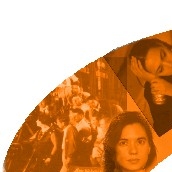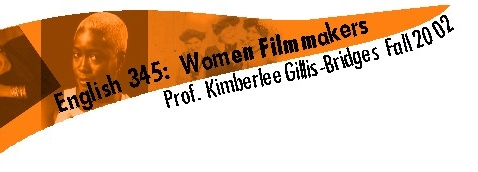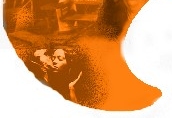


| Course M, 2:30-5:20 W, 2:30-4:20 Thomson 125 |
| Instructor K. Gillis-Bridges Padelford A305 543-4892 MW, 1:00-2:20 |
| Page last updated 12/9/02 |

Sample Essay
A Comparison and Contrast of Endings in Cleo from 5 to 7 and Blue Steel
The ending of a film is arguably the most important part, and Cleo from 5 to 7 and Blue Steel are no exception. The end sequences are approached differently by Varda and Bigelow, as can only be expected when comparing a mid-20th century French New Wave artist and contemporary director, but enough similarities exist to warrant a comparison. The two directors use different narrative and formal elements in their ending scenes but strive to accomplish the same goal – that of marking a deliberate and dynamic shift in the female lead’s concept of self.
The difference in the narrative format of the endings scenes is obvious: Cleo from 5 to 7 focuses on the intimate verbal interaction between Florence and the soldier Antoine while Blue Steel ends with the taciturn gun battle typical of action films. The difference can be attributed to the simple fact of genre. The goal of the main character in action-films is usually accomplished via violence and a quest for self-actualization is often realized through meaningful conversation. Florence and Megan are both fighting against an enemy. Megan’s foe is the physical embodiment of her need to prove herself in a man’s world while Florence’s adversary is her own narcissism and objectification by others.
Guns and words, seemingly incongruous, are similar here in that they both work as vehicles of change for the two women. It is through her conversation with Antoine that Florence is able to cope with the anxiety of waiting for potentially dire test results and his enthusiasm for life lends her the strength to overcome Dr. Valentino’s news of her cancer. Although certainly not the only influence on Florence’s self-transformation, he is the last and final interaction of the two hours. Florence’s conversation with Antoine is strikingly different than it was with her earlier male relationships. In contrast to being considered an “idiot, incapable, a talking doll” by her male composers, her and Antoine freely share their fears and dreams and it’s clear that Florence is possessed of a new self-awareness. When Dr. Valentino confirms her earlier fear of cancer, she can respond not with the earlier fatalistic statement “As long as I have my beauty, I am alive,” but rather with the reflective musing, “My fear seems to have gone…I seem to be happy.”
The absence of narration, and the corresponding focus on the fetishized guns, in the final scene of Blue Steel serves much of the same purpose as the dialogue in Cleo from 5 to 7. Megan’s need at the end of the film is not to attain reflective self-awareness but to establish her role in the male-dominated world of police enforcement. In the final scene no words are needed; the plot lines have all been established and all that remains is the physical struggle for dominance between Eugene and Megan. One could even split the analysis along stereotypical gender lines. Verbalization is typically thought of as a female trait and silence as a male trait. Megan is searching for acceptance in the male world, and achieves her goal through non-verbal violence while Cleo is searching for a “feminine” social awareness and achieves her change via intimate conversation.
In addition to narration, or the lack thereof, Varda and Bigelow explore the dynamic changes in their main characters through the construction of specific music and camera shots. The music of the climatic battle scene in Blue Steel is a subtle techno-action beat that emphasizes both the surrealism and violence of the gun battle. In Cleo from 5 to 7; however, the music is non-existent until the very last frames of the end. The difference in the musical choice seems to be, as with the narrative differences, a function of the genre. The ending scene in Varda’s film is eerily silent, rendering each spoken word, relevant or otherwise, important and lending nuance to each syllable. This focuses the viewer’s attention on the words spoken, which is appropriate because the final scene revolves around the spoken word and its reflection of Florence’s inner state. Only after Florence has declared her acceptance and happiness, and the viewer has had time to meditate on the final words, does Varda crescendo the music into the credit scene. Bigelow, by contrast, let’s her ethereal techno music play continuously, reflecting the pace of the action. At the climax of the scene, as Megan takes aim at Eugene’s chest, the music crescendos only to abruptly go silent, accentuating the three loud bursts of gunfire that end the conflict. The difference between the two uses of music reflects the pacing of the climatic moment. In Cleo from 5 to 7, Florence is slowly realizing her newfound self-awareness through her relationship with Antoine. The pace is slow, steady, and somewhat idyllic. Music would only detract from the quiet stillness that lends so much weight and dignity to their conversation. In Blue Steel, however, the pace is anything but slow. Kathryn Bigelow shoots the final scene at a frenetic pace, and the increasing tempo of the music follows the increase in the action. Megan resolves her great conflict in a final climatic space of a few seconds and the use of dramatic music delineates this space of time for the viewer.
The pacing of the final scene is defined even stronger through the director’s choice of camera shots. In Cleo from 5 to 7 the slow, thoughtful progression of awareness is reflected in the slow pan shots across well-maintained gardens, tall evergreen trees, and the beautiful chateau. As Antoine and Florence stroll hand-in-hand down the sidewalk a single camera, typical of new wave cinema, passively follows their conversation. When Antoine and Florence sit down on a bench beside the street, there is a wide-angle distance shot symmetrically framing the two between the trees, almost as if to demonstrate Florence’s expanding concept of self. The strongest use of camera shot by Varda to emphasize this expanded gaze is the final sequence of frames. As the film closes, Florence and Antoine are slowly walking together, and suddenly quickly look into each other’s eyes. A hint of musical chimes plays in the background, and then the two glance away. They walk for a moment longer then turn to stare deeply into each other’s eyes as the music starts and the credits roll. Florence no longer requires a mirror to see herself, but can share love and self-awareness with another.
The role of the camera and visual language in the final scene of Blue Steel is different than in Cleo from 5 to 7. From the very start the pacing is much wilder. At the very beginning of the ending sequence, Eugene is stalking Megan in a subway station, staggering behind her with a gun in hand. As Eugene raises his gun, Megan suddenly spins and shoots first. The distinction that Megan spun before actively seeing Eugene is an important one to make. In all previous scenes, she lacked what her instructor in the academy called “having eyes in the back of her head.” At this point she is the one in control and has finally developed her “gaze” to the level necessary to be a successful police officer. As the fight continues, the camera angles flash back and forth from Eugene to Megan, each respective gunshot endowing the shooter with the privilege of his or her own close-up and adding to the feel of a very personal conflict – as opposed to a more generic exchange of gunfire. When the scene nears its conclusion, and Eugene stands in front of Megan’s car uncomprehendingly trying to fire his empty gun, Megan slowly raises her head and the first thing the viewer notices are her eyes rising above the shattered window frame. This is once again representative of the new expanded “gaze” of Megan. As she raises the gun, the camera focuses in on her face and leaves the gun as a blur in the foreground. Here it seems rational to conjecture that Bigelow is playing once more with the symbolism of the gun. Up to this point, the gun had been the dominant focus of the imagery and the driving force behind the characters actions. Now, Bigelow shows that Megan has taken control. It is her, not an obsession with the gun or the masculine power it represents, that is the focus of the current dynamic. But Bigelow returns the focus to the gun for the second and third shots, insinuating that the symbol is still in control. As the third and final shot rings out, the focus of the camera slowly refocuses on Megan’s face and the blurred gun drops from her hand to bounce several times on the seat of the car. The conflict is resolved, her enemy is dead, and the gun has retreated from focus and been replaced by internal strength.
In Cleo from 5 to 7 by Agnes Varda and Blue Steel by Kathryn Bigelow the directors use different narrative and formal elements in their ending sequences as vehicles for the expression of a common theme. Although one film is the product of a 1962 New Wave director and the other a 1990 contemporary action film, both movies focus on the internal revolution of the female character and her struggle to find her place in the world.
Copyright 2002 Chris Henrichsen
Essay may not be reproduced in any form without
the express permission of the author.
Essay may not be reproduced in any form without
the express permission of the author.